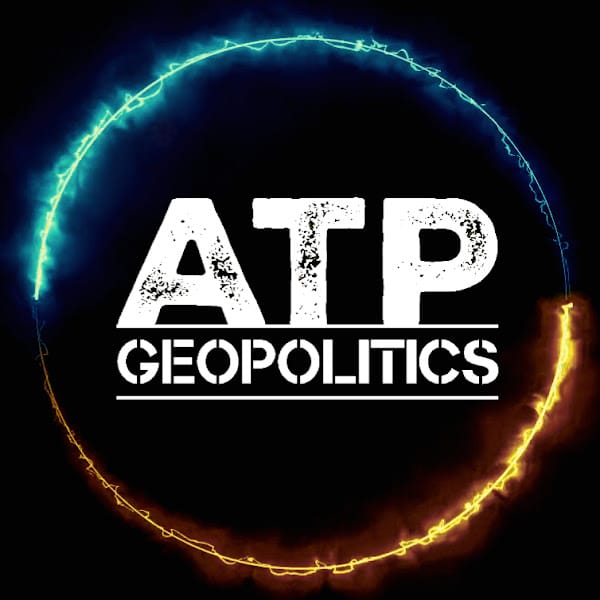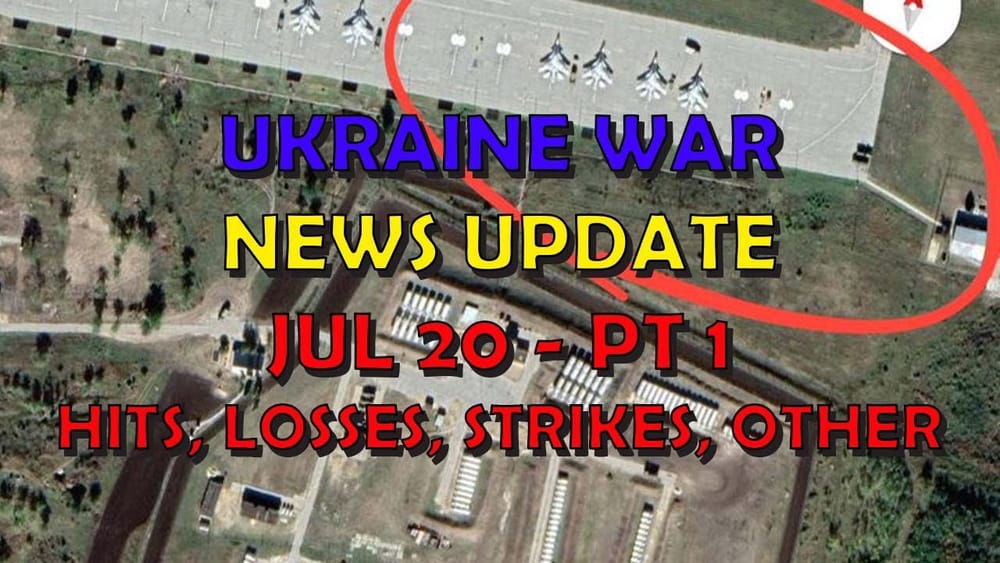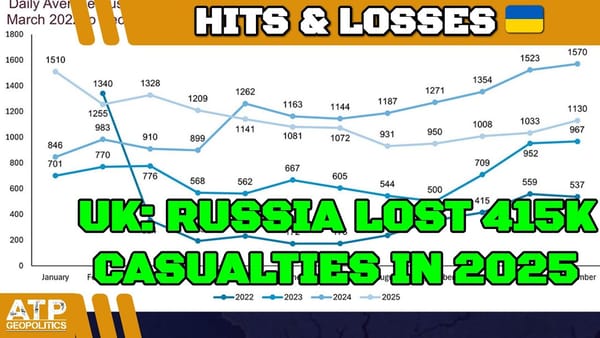Ukraine War Update NEWS: Pt 1 - Overnight & Other News
Table of Contents 📖
"Pick an airfield, pick an airfield, 100 drones to smash that airfield."
Hello Team
🎦 00:00-00:23⏩
Jonathan welcomes viewers back to ATP Geopolitics, noting that this is a re-recording due to technical difficulties with YouTube. He mentions the day's Russian losses have been "fairly typical", just under 1000 personnel, and speculates that the extreme heat may be a contributing factor to lower activity levels.
Return to top⤴️
🪦 DISCLAIMER FOR GENERAL STAFF LOSSES DATA
- These are real people with real lives and real families who love them. Don’t let the numbers sap your humanity.
- These numbers probably aren’t accurate but they’re the best we have and we don’t need them to be accurate to be indicative of patterns of activity.
- All losses are estimates. Losses cannot be counted with accuracy because of the conditions on the ground.
- Both sides would see it to be of their advantage to minimize their own losses maximize the other side’s losses.
- Neither side releases their losses but we have enough transparency from the Ukrainian side to have confidence in they are indicative.
- Personnel losses are hard to count. If a soldier gets injured, heals up, and returns to the front line only to get injured again, is that one loss or two? Also, how to deal with losses from PMC’s or soldiers fighting with RF from occupied territories?
- Equipment losses are hard to count. If an AA complex involves several parts and one part gets disabled, is that a loss, or a fraction of a loss? If a tank gets disabled, repaired, back into the fight, then disabled again, is that one lost tank or two?
- All recorded losses are vulnerable to multiple reporting. We have already seen numerous cases of multiple drones in the air reporting the same loss from different angles as multiple engagements.
- Losses are not always reported on the same day they occurred. It is frequent that drone losses are reported at least 24 hours after other terrestrial equipment losses. Certain losses may not be reported for days or weeks for military intelligence reasons.
Russian and Ukrainian Losses
🎦 00:23-04:51⏩
Jonathan reviews the day's losses, drawing on data from sources like Oryx and Warspotting. He notes that while overall equipment losses are higher for Russia, Ukrainian losses are not insignificant and will be felt. He points out that the ratio of Russian to Ukrainian losses is more favorable for Ukraine when looking specifically at combat assets. He highlights the significance of the loss of a P-18 radar for Ukraine. On the Russian side, he observes the continued trend of older equipment being lost, including a T-62 modified in 1975, indicating the depth of their reserves but also potential future challenges. Jonathan emphasizes the importance of understanding the context of loss figures, noting that the proportion of damaged versus destroyed equipment can be telling.
Return to top⤴️
Russian Military Morale
🎦 04:51-05:19⏩
Jonathan cites a report from WarTranslator, based on Russian 1307th regiment soldier testimonies, expressing concerns about the influx of old and untrained personnel, with some seemingly resigned to dying. He contrasts this with attempts to portray the Russian army as highly motivated and suggests the reality is more complex.
Return to top⤴️
Estimated Russian Personnel Losses: Corroborating the Numbers
🎦 05:19-08:05⏩
Jonathan delves into the question of Russian personnel losses, emphasizing the consistency between Estonian intelligence estimates of 1,000 deaths per day and figures from the Ukrainian General Staff. He argues that this corroboration, combined with evidence from sources like the BBC/Mediazona investigation, social media obituaries, payments to families, and anecdotal reports, strengthens the credibility of Ukrainian claims. He contrasts this with what he sees as "fanciful" and "impossible" figures from Russian state-controlled outlets like TASS.
Return to top⤴️
Analysis of Russian Equipment Stockpiles
🎦 08:05-19:33⏩
Jonathan shifts to a detailed analysis of Russian equipment stockpiles, drawing heavily on insights from Richard Vareka (Warspotting). Key takeaways include:
- IFVs and APCs: While Russia has more than half its pre-war stock remaining, the most modern IFVs (BMP-2s and BMP-3s) are dwindling, forcing them to rely on older and less capable models.
- Tanks: Similar to IFVs, Russia has lost a significant portion of its best tanks (T-90s, T-80s, modern T-72s). While they still have a large numerical advantage, the quality of their remaining tank force is declining.
- Artillery: The situation with artillery is less clear-cut, but there are signs of strain. The appearance of older towed guns (M-46 130mm) suggests they are digging deeper into their reserves. Jonathan discusses the possibility of Russia "cannibalizing" towed guns for barrels to keep self-propelled guns operational, a theory based on observed loss patterns.
- Ammunition: While difficult to quantify, ammunition is likely a significant limiting factor for Russia, especially given their high rate of fire. Jonathan cites the use of older caliber ammunition, possibly from North Korea, as an indicator of potential shortages. He also notes the limitations of relying solely on visually confirmed losses from open sources, as artillery losses, particularly those due to counter-battery fire, are harder to verify.
- MLRS: Russia has lost a concerning percentage of its multiple launch rocket systems (MLRS), potentially creating another vulnerability.
Jonathan emphasizes that while some have prematurely declared Russia on the verge of running out of equipment, their reserves are not limitless. He argues against a protracted war of attrition and advocates for a decisive surge in Western military aid to enable Ukraine to achieve a decisive victory.
Return to top⤴️
Suboptimal Equipment: A Russian Weakness or Unexpected Advantage?
🎦 19:33-22:33⏩
- Jonathan discusses a tweet by TrentTolkienenko pointing out the seemingly illogical use of recently modernized T-80 tanks as improvised "turtle tanks" (with limited turret movement) suggesting potential issues with Russia's ability to repair and maintain its more advanced equipment.
- He analyzes footage of a Russian attack in the Urazhina area involving a large number of motorcycles, noting that while seemingly indicative of equipment shortages, this tactic may offer unexpected advantages. Jonathan posits that motorcycles, being smaller and more dispersed targets, are less vulnerable to artillery and mines compared to traditional IFVs.
The Drone War: Ukraine Gains an Edge
🎦 22:33-23:14⏩
Jonathan highlights a growing disparity in drone capabilities, with Russian sources acknowledging the superiority of Ukrainian drones, both in quantity and quality. He cites reports of a 10:1 ratio of Ukrainian to Russian FPV drones and notes Ukrainian successes with larger, more sophisticated models like the "Baba Yaga." This shift in the drone war, he suggests, is a testament to Ukraine's own development efforts and the crucial support of its allies.
Return to top⤴️
Fires and Strikes: Targeting Russian Infrastructure
🎦 23:14-23:43⏩
Jonathan covers recent incidents of fires and strikes, including:
- A large fire at a motor oil production plant in the Moscow region.
- Ukrainian air defense successfully intercepting 12 out of 16 Russian drones overnight.
- Damage to a railroad in Kharkiv Oblast, impacting civilian infrastructure and train schedules between Kyiv and Kramatorsk.
Tragedy in Mykhailivka: Russian Missile Strike Kills Civilians, Including a Child
🎦 23:43-27:05⏩
Jonathan expresses his anger and sadness over a Russian missile strike on Mykhailivka that hit a children's playground, killing at least three people, including a 12-year-old boy named Kirill Dyadyushka, who was passionate about traditional Ukrainian dancing. He condemns the attack as barbaric and calls for increased international pressure on Russia to end the violence. He shares Zelensky's condemnation of the attack and call for increased support for Ukraine's defense. Jonathan expresses concern over what he sees as a pattern of indiscriminate Russian shelling and bombing targeting civilian infrastructure.
Return to top⤴️
A Call for Proactive Strikes on Russian Airbases
🎦 27:05-29:45⏩
Jonathan argues that given the significant threat posed by Russian guided glide bombs, cruise missiles, and ballistic missiles launched from aircraft, Ukraine's top priority should be neutralizing Russian air bases within Russia. He expresses frustration with what he perceives as Western reluctance to allow the use of supplied weapons systems for such strikes, particularly in light of the devastating consequences for Ukrainian civilians. He questions the logic of permitting strikes on airbases in Crimea (which Russia considers part of its territory) while prohibiting those on bases within Russia proper.
Return to top⤴️
Ukrainian Drone Strike on Milorovo Airbase
🎦 29:45-32:02⏩
Jonathan analyses a successful Ukrainian drone strike on Milorovo airbase in Rostov Oblast, Russia. He highlights:
- The airbase's proximity to the Ukrainian border (20 km), placing it beyond the range of Western-supplied weapon systems.
- Reports of 16 explosions, multiple fires, and significant damage to the airfield, potentially including aircraft and fuel depots.
- The importance of hardened aircraft shelters as a defense against drone attacks, a point repeatedly raised by Russian military analysts.
- The strategic significance of targeting oil depots and air traffic control infrastructure to cripple an airbase's operational capacity.
Analysis of the Aftermath of Ukrainian Strikes
🎦 32:02-34:39⏩
Jonathan reviews the aftermath of several Ukrainian strikes:
- Evidence suggesting the destruction of a Russian S-300 VM air defense system in Luhansk Oblast.
- Satellite imagery confirming damage to a Russian military base in Novoazovs'k (Donetsk Oblast), including what appears to be destroyed ships.
- Footage of a Ukrainian drone strike disabling a gas distribution point and multiple substations in the Belgorod region, demonstrating the vulnerability of critical infrastructure.
Record Temperatures: A Global Crisis with Battlefield Implications
🎦 34:39-36:25⏩
Jonathan discusses the unprecedented global heatwave, noting that June 2024 was the warmest June on record globally, marking the 13th consecutive month of record-breaking temperatures. He dismisses attempts to downplay the role of climate change and highlights the impact of extreme heat on the conflict, both in terms of battlefield conditions and energy demands.
Return to top⤴️
Power Outages Plague Crimea and Russia, Sparking Protests
🎦 36:25-40:18⏩
Jonathan focuses on widespread power outages in Crimea and Russia, linking them to a combination of factors:
- Increased Demand: Record-breaking heat driving up air conditioning usage.
- Infrastructure Vulnerability: Successful Ukrainian strikes on energy infrastructure.
- Sanctions and Supply Chain Issues: Russia's inability to easily replace critical components for its electrical grid due to sanctions and its reliance on Ukrainian suppliers before the war.
- Loss of Expertise: The conscription and subsequent deaths of skilled technicians and engineers.
He sees these outages as evidence of the unintended consequences of Russia's invasion and highlights their potential to fuel internal unrest. He specifically mentions protests in Krasnodar, where residents have been without power for days, and notes the strategic value of such dissent for Ukraine. Jonathan sardonically praises Perpetua's tweet thread about the unfolding situation, noting the ironic self-inflicted nature of Russia's energy woes.
Return to top⤴️
Assassination of Ukrainian Politician and Internal Discord in Russia
🎦 40:18-41:58⏩
Jonathan covers:
- The assassination of Irina Farion, a former Ukrainian MP known for her strong pro-Ukrainian language stance, which had drawn criticism from some within the military.
- A water crisis in Donetsk caused by a burst pipeline, adding to the challenges faced by Russian-backed separatists.
- Growing tensions within Russia itself, citing reports of a Muslim family in Dagestan being attacked for their son's involvement in the "special military operation." This incident highlights the complex ethnic and religious dynamics within Russia and the potential for the war to exacerbate internal divisions.
Ukraine Cuts Off Oil to Hungary: A Risky Gamble?
🎦 41:58-43:37⏩
Jonathan discusses Ukraine's decision to halt oil flows to Hungary through pipelines traversing its territory. He frames this as a bold move driven by frustration with Hungary's increasingly pro-Russian stance and perceived attempts to undermine Ukraine's relationship with the West. He questions whether Ukraine has miscalculated and risks pushing Hungary further into Russia's arms or if this gamble might give them leverage over Orbán's government.
Return to top⤴️
Predictions: More Drone Attacks to Come as Ukraine Stockpiles
🎦 43:37-45:29⏩
Jonathan concludes by predicting an increase in Ukrainian drone attacks on Russian targets, arguing that Ukraine is likely stockpiling domestically produced drones for this purpose. He reiterates his belief in the effectiveness of concentrated drone swarms against high-value targets like airbases, drawing a contrast with what he sees as Russia's less focused approach. He acknowledges the challenge posed by scrambled aircraft evacuations in response to drone attacks and speculates that faster, more difficult-to-intercept missiles like the ATACMS could be a more effective solution. He emphasizes the need to cripple airfield infrastructure, particularly fuel depots and air traffic control, to hinder Russian air operations.
Return to top⤴️
Wrap up
🎦 45:29-45:37⏩
Jonathan wraps up the extensive update, acknowledging its length and thanking viewers for their attention.
Return to top⤴️




